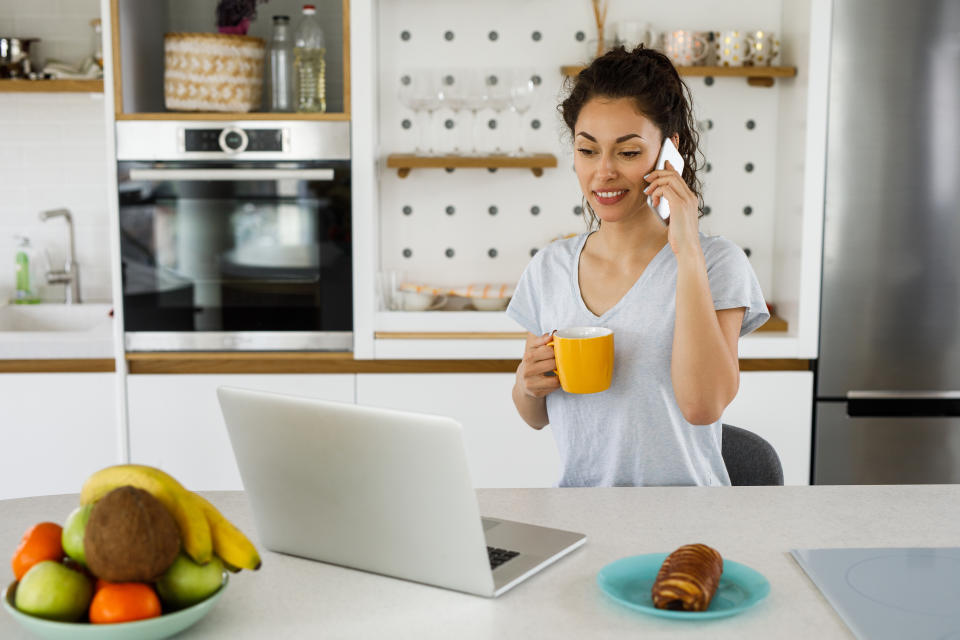Coronavirus: Here's how to make the best work-from-home arrangement
An increasing number of Americans are working from home to slow the spread of the coronavirus, or COVID-19.
Without much warning, workers have been mandated by their state government, employer, or both, to quickly shift from working in an office to their home for an indefinite period of time while maintaining productivity.
For those who are able to work remotely, many are making the best of an otherwise less-than-ideal arrangement, even when it means working in the confines of small spaces, contending with children, pets, a spouse, or roommates.
Cashay consulted the experts for guidance on how to settle into a new routine and create a functioning and efficient work-from-home set-up.

‘At the end of the day, put the lid on it’
When a dedicated office exceeds your home’s space limitations, Effy Terry, professional organizer and trained Marie Kondo consultant, suggested creating a mobile office by keeping your supplies in a bin.
When working from a multi-purpose surface like the kitchen table, you can still draw a distinction between work and play. At the end of the workday, pack up your supplies into a basket or bin and put it out of sight to symbolize the transition from work to personal time.
“You can put that bin in a closet or somewhere where it's not impeding on your ability to have dinner with your family,” Terry said. “And then at the end of the day, put the lid on it. Days over.”
‘Keep the desk as clear as possible’
Take stock of your office supplies — aside from your computer — that typically sit atop your desk like headphones, calculator, pens, paper, paperclips, highlighters, and stapler. Evaluate what you use everyday and only keep those items on your desk. All other items can be placed in drawers or reusable or repurposed bins like shoe boxes.
The goal is to “keep the desk as clear as possible and clutter-free as possible,” Terry said. Tying up loose cables and wires, and putting away electronics will contribute to a tidy environment and “less physical clutter results in less mental clutter,” she said.

Institute office hours, if possible
To minimize distractions from family members and roommates, Terry suggested hanging a sign outside your makeshift office that says you’re busy and prefer not to be interrupted. Make it clear to others in the home that — barring emergencies — you’re requesting privacy.
Optimize for ergonomics
Whether your job requires you to primarily sit or stand, proper posture is paramount, said Pamela McCauley, professor and director at the ergonomics laboratory at the University of Central Florida.
“What you want is that lumbar support that creates that natural curvature of the lower back,” she said. “And then the upper back will then straighten up and into the back in sort of like an S curve.”
Utilizing ergonomic strategies to minimize the physical stress and fatigue of working doesn’t necessarily require a hefty cash outlay.
An ergonomic chair can run from $100 to upwards of $500, but McCauley offered a thrifty hack.
“If you can't get an ergonomic chair, you can take a bath towel and roll it up, and actually put it in the lower back and your lower back region, and lean back on that to create temporary lumbar support,” she said.
If buying a standing desk isn’t in the cards, McCauley suggested finding boxes or thick books to stack on your table to make your screen eye level. Another key placement: The optimum distance from your screen is about 20 to 30 inches.

Tiny investments can go a long way
When major changes like building a new dedicated office just aren’t possible, there are ways to get creative and make the most of your makeshift workspace.
Headphones and a privacy screen on your computer can help boost the semblance of confidentiality in a shared workspace. Repositioned furniture, like a bookcase, can also act as a divider wall that doubles as a storage center.
Green is a calming color, but when painting your walls isn’t an option, McCauley shared that you can inject a little green and achieve the same peace with a potted plant or fresh flowers.
Daylight is the best source of natural light, but in its absence, you can swap out a low wattage light bulb for something brighter. A properly lit space can elevate your productivity and make for more inviting video conferences.
Stephanie is a reporter for Yahoo Money and Cashay, a new personal finance website. She can be reached at stephanie.asymkos@yahoofinance.com. Follow her on Twitter @SJAsymkos.
Read more information and tips in our Career section





